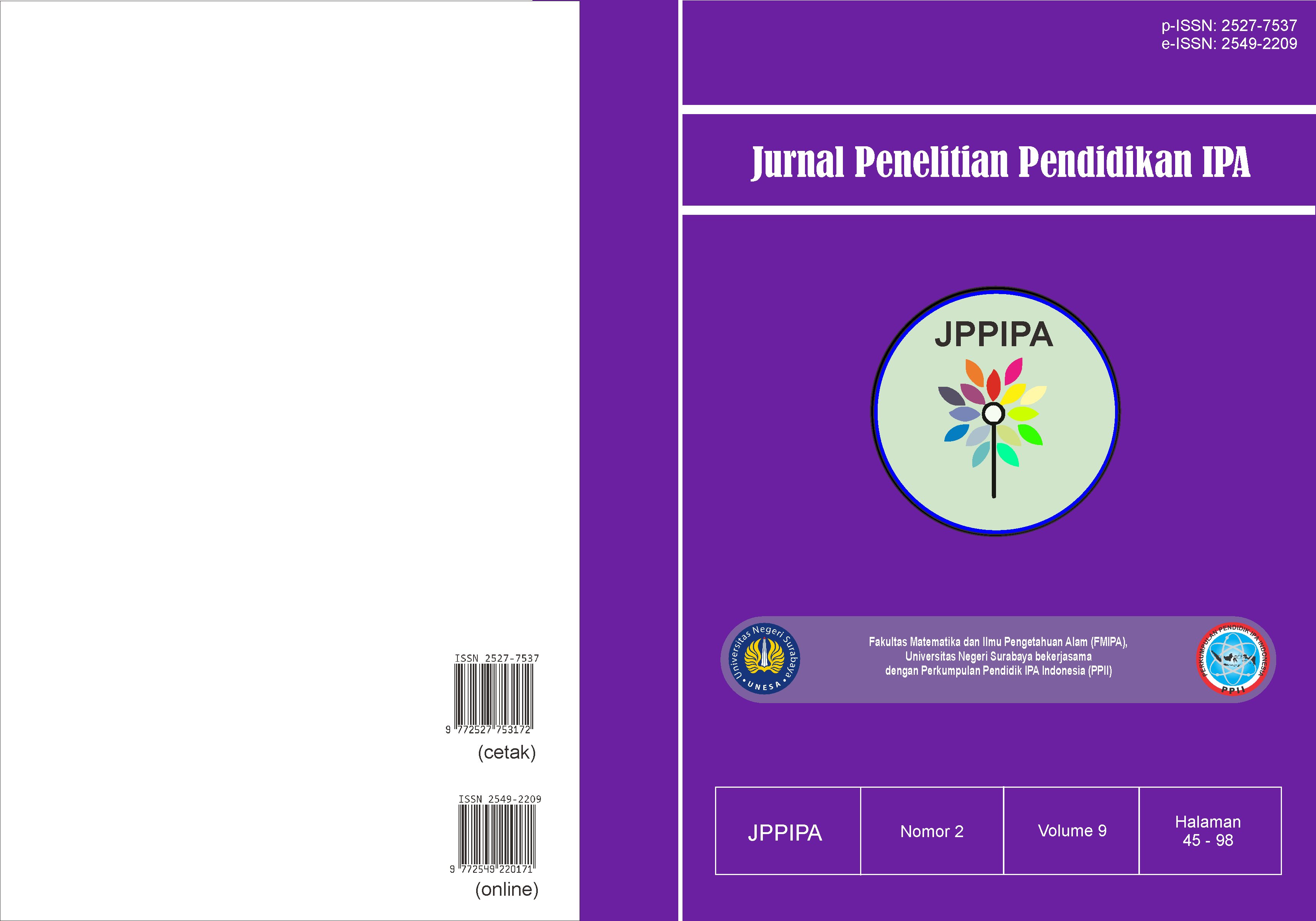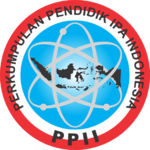ANALYSIS STUDENTS INTEREST IN AN INTEGRATIVE CONTEXT: A DESCRIPTIVE AND COMPARATIVE STUDY IN CHEMISTRY LEARNING
DOI:
https://doi.org/10.26740/jppipa.v9n2.p45-54Keywords:
Chemistry, Interest, Learning, Mathematics IntegrationAbstract
Understanding students’ interest in learning chemistry is essential for educators to design effective teaching strategies and promote academic success. This study aims to investigates the learning interest in chemistry among students at different grade levels in SMAN 7 Kerinci, focusing on the integration of mathematics with chemistry lessons. Through descriptive and comparative analyses, we examine the factors influencing students’ interest in chemistry and its integrative context with mathematics. Our findings reveal that students’ interest in learning chemistry tends to decline as they progress through higher grade levels, with 11th grade students showing a higher interest compared to 12th grade students. Additionally, the integration of mathematics with chemistry poses challenges for students, impacting their interest levels. This study underscores the importance of innovative teaching approaches to enhance students’ interest and engagement in chemistry education. Further research is needed to explore the underlying factors influencing students’ interest in learning chemistry comprehensively. By understanding these factors, educators can develop targeted interventions to foster students’ interest and passion for chemistry, ultimately promoting academic success and nurturing future scientists and innovators.
References
Adu-Gyamfi, K. (2013). Lack of interest school science among non-science students at the senior high school level. Problems of the Education in the 21st Century, 53(1), 7–21.
Akram, T. M., Ijaz, A., & Ikram, H. (2017). Exploring the Factors Responsible for Declining Students’ Interest in Chemistry. International Journal of Information and Education Technology, 7(2), 88–94. https://doi.org/10.18178/ijiet.2017.7.2.847
Alfarisi, M. A. (2018). Aplikasi Media Pembelajaran Unsur-Unsur Kimia Berbasis Android. JATI ( Jurnal Mahasiswa Teknik Informatika ), 2(1), 1–5.
Anggorowati, S. (2020). ANALISIS MINAT BELAJAR KIMIA PESERTA DIDIK KELAS XII SMA NEGERI 6 YOGYAKARTA. Jurnal Ilmiah WUNY, 2(1). https://doi.org/10.21831/jwuny.v2i1.30952
Anggraini, S., & Efendi, N. (2023). Analisis Implementasi Pemanfaatan Lingkungan Sekolah untuk Meningkatkan Motivasi Belajar Siswa pada Mata Pelajaran IPA di Sekolah Dasar. Jurnal Pendidikan Dasar Flobamorata, 4(2), 552–562. https://doi.org/10.51494/jpdf.v4i2.973
Awe, E. Y., & Benge, K. (2017). Hubungan Antara Minat Dan Motivasi Belajar Dengan Hasil Belajar Ipa Pada Siswa Sd. Journal of Education Technology, 1(4), 231. https://doi.org/10.23887/jet.v1i4.12859
Béchard, N., Langlois, S., Poliquin, G., & Cyr, S. (2021). Development of the SMIQ questionnaire measuring interest, sense of self-efficacy and perception of the links existing between mathematics and science in an integrated context. Mesure et Évaluation En Éducation, 44, 129–165.
Cahyani, V. D., & Pranata, O. D. (2023). Studi Aktivitas Belajar Sains Siswa di SMA Negeri 7 Kerinci. Lensa (Lentera Sains): Jurnal Pendidikan IPA, 13(2), 137–148. https://doi.org/10.24929/lensa.v13i2.317
Hartini, A., & Faridah, S. (2022). Factors causing low interest in learning science in elementary school. Journal 0f Oustainable Development Science, 4(2), 30–41.
Hemayanti, K. L., Muderawan, I. W., & Selamat, I. N. (2020). Analisis minat belajar siswa kelas XI MIA pada mata pelajaran kimia. Jurnal Pendidikan Kimia Indonesia, 4(1), 20–25.
Kang, J., Hense, J., Scheersoi, A., & Keinonen, T. (2019). Gender study on the relationships between science interest and future career perspectives. International Journal of Science Education, 41(1), 80–101. https://doi.org/10.1080/09500693.2018.1534021
Kind, V., & Aston, K. (2022). Teaching secondary chemistry (V. Kind & K. Aston (eds.); 3rd ed.).
Komariyah, S., Afifah, D. S. N., & Resbiantoro, G. (2018). Analisis pemahaman konsep dalam memecahkan masalah matematika ditinjau dari minat belajar siswa. SOSIOHUMANIORA: Jurnal Ilmiah Ilmu Sosial Dan Humaniora, 4(1).
Kurniawan, A., & Astuti, A. P. (2017). Deskripsi Kompetensi Pedagogik guru dan calon guru Kimia SMA Muhammadiyah 1 Semarang. In Prosiding Seminar Nasional & Internasional.
Kurniawati, E., Kurniati, T., & Kurniawan, R. A. (2017). Deskripsi kemampuan matematika dan korelasinya dengan hasil belajar siswa pada mata pelajaran kimia kelas X MIPA SMA Negeri 4 Pontianak. Ar-Razi Jurnal Ilmiah, 5(2).
Lamb, R. L., Annetta, L., Meldrum, J., & Vallett, D. (2012). Measuring Science Interest: Rasch Validation of the Science Interest Survey. International Journal of Science and Mathematics Education, 10(3), 643–668. https://doi.org/10.1007/s10763-011-9314-z
Morgan, G. A., Leech, N. L., Gloeckner, G. W., & Barret, K. C. (2004). SPSS for Introductory Statistics. Use and Interpretation. Lawrence Erlbaum Associates, Inc. All.
Potvin, P., & Hasni, A. (2014). Analysis of the Decline in Interest Towards School Science and Technology from Grades 5 Through 11. Journal of Science Education and Technology, 23(6), 784–802. https://doi.org/10.1007/s10956-014-9512-x
Pranata, O. D. (2021). Pelatihan Kompetisi Sains Nasional (KSN) Cabang Matematika Tingkat SMP/MTs melalui Pembelajaran Berbasis Puzzle. Jurnal Pengabdian Masyarakat MIPA Dan Pendidikan MIPA (JPMMP), 5(2), 118–124. https://doi.org/10.21831/jpmmp.v5i2.42276
Pranata, O. D. (2023). Penerapan Puzzle-Based Learning untuk Mengajar Matematika dan Sains di Pasantren dengan Kelas Heterogen. Jurnal Penelitian Dan Pengabdian Kepada Masyarakat UNSIQ, 10(2), 109–115.
Pranata, O. D., Sastria, E., Ferry, D., & Zebua, D. R. Y. (2023). Analysis of Students’ Emotional Intelligence and Their Relationship with Academic Achievement in Science. Proceedings of the International Conference on Social Science and Education, ICoeSSE, 395–410. https://doi.org/10.2991/978-2-38476-142-5
Putra, I. P. O. P., Pujani, N. M., & Priyanka, L. M. (2023). Analisis Minat Belajar Ipa Pada Pembelajaran Daring. Jurnal Pendidikan Dan Pembelajaran IPA Indonesia, 11(2), 22–31. https://doi.org/10.23887/jppii.v11i2.60897
Putri, A. L., Pranata, O. D., & Sastria, E. (2024). Students Perception of Science and Technology in Science Learning: A Gender Comparative Study. Jurnal Pijar Mipa, 19(1), 44–50. https://doi.org/10.29303/jpm.v19i1.6153
Putri, D. H., & Pranata, O. D. (2023). Eksplorasi Kejenuhan Siswa dalam Pembelajaran Sains Setelah Pandemi. Jurnal Inovasi Pendidikan Sains (JIPS), 4(2), 62–70. https://doi.org/https://doi.org/10.37729/jips.v4i2.3367
Renninger, K. A., Nieswandt, M., & Hidi, S. (2015). Interest in Mathematics and Science Learning. American Educational Research Association (AERA).
Ríordáin, M. N., Johnston, J., & Walshe, G. (2016). Making mathematics and science integration happen: key aspects of practice. International Journal of Mathematical Education in Science and Technology, 47(2), 233–255.
Sanjiwani, N., Muderawan, I., & Sudiana, I. (2018). Analisis Kesulitan Belajar Kimia Pada Materi Larutan Penyangga Di Sma Negeri 2 Banjar. Jurnal Pendidikan Kimia Undiksha, 2(2), 75. https://doi.org/10.23887/jjpk.v2i2.21170
Sari, R. N., & Maharani, E. T. W. (2019). Minat Belajar Kimia Siswa Kelas X MIPA di Madrasah Negeri Kota Semarang. Seminar Nasional Edusaintek, 552–561. http://prosiding.unimus.ac.id
Taber, K. S., & García-Franco, A. (2010). Learning processes in chemistry: Drawing upon cognitive resources to learn about the particulate structure of matter. Journal of the Learning Sciences, 19(1), 99–142. https://doi.org/10.1080/10508400903452868
Treagust, D. F., Chandrasegaran, A. L., Zain, A. N. M., Ong, E. T. E. T., Karpudewan, M., & Halim, L. (2011). Evaluation of an intervention instructional program to facilitate understanding of basic particle concepts among students enrolled in several levels of study. Chemistry Education Research and Practice, 12(2), 251–261. https://doi.org/10.1039/c1rp90030g
Tümay, H. (2016). Reconsidering learning difficulties and misconceptions in chemistry: Emergence in chemistry and its implications for chemical education. Chemistry Education Research and Practice PERSPECTIVE, 17(2), 1–15. https://doi.org/10.1039/x0xx00000x
Ulandari, S., Pranata, O. D., & Kencanawati, I. (2024). Analisis Minat Siswa dalam Konteks Integratif: Studi Deskriptif dan Komparatif dalam. Jurnal Pendidikan MIPA, 14(1), 131–138. https://doi.org/https://doi.org/10.37630/jpm.v14i1.1486
van Griethuijsen, R. A. L. F., van Eijck, M. W., Haste, H., den Brok, P. J., Skinner, N. C., Mansour, N., Gencer, A. S., & BouJaoude, S. (2015). Global patterns in students’ views of science and interest in science. Research in Science Education, 45(4), 581–603. https://doi.org/10.1007/s11165-014-9438-6
Vilia, P. N., Candeias, A. A., Neto, A. S., Franco, M. da G. S., & Melo, M. (2017). Academic achievement in physics-chemistry: The predictive effect of attitudes and reasoning abilities. Frontiers in Psychology, 8(JUN), 1–9. https://doi.org/10.3389/fpsyg.2017.01064
Yakina, Y., Kurniati, T., & Fadhilah, R. (2017). Analisis kesulitan belajar siswa pada mata pelajaran kimia kelas X di SMA Negeri 1 Sungai Ambawang. Ar-Razi Jurnal Ilmiah, 5(2).
Downloads
Published
How to Cite
Issue
Section
 Abstract views: 551
,
Abstract views: 551
, PDF Downloads: 280
PDF Downloads: 280












